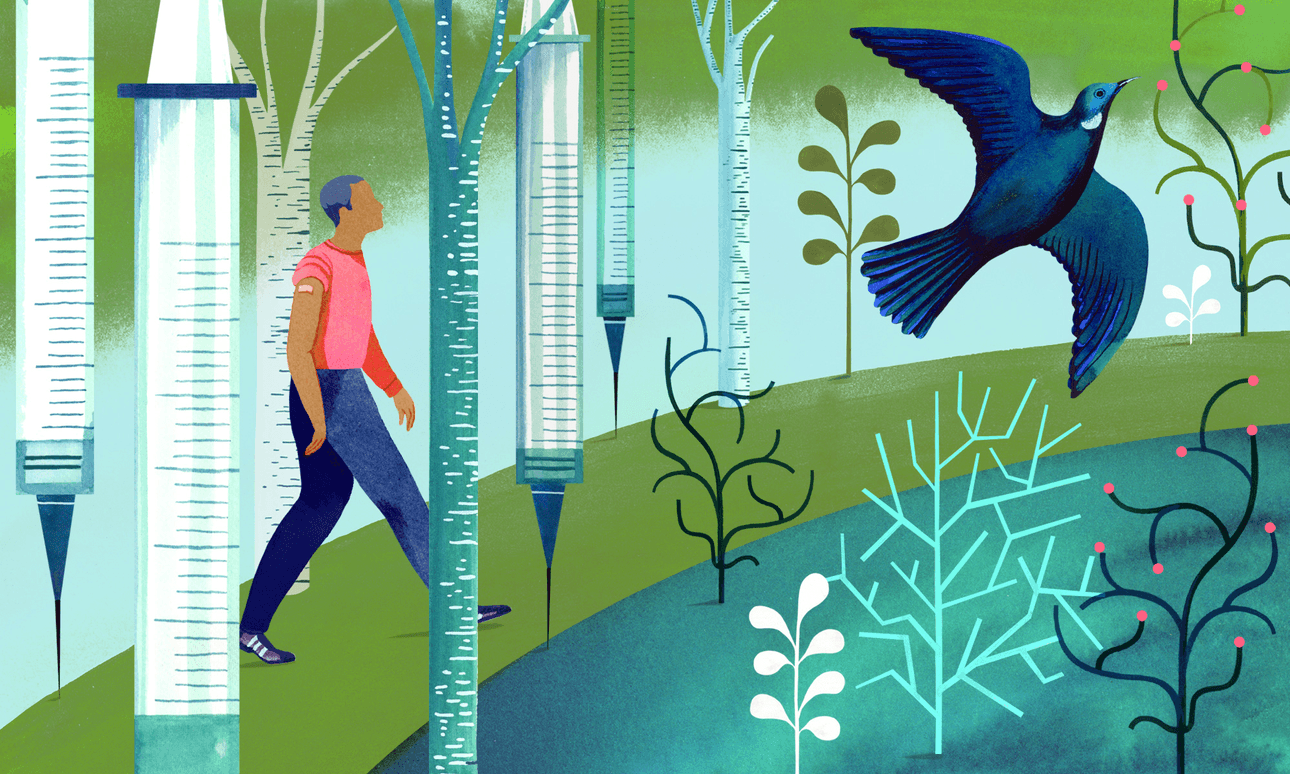Author and intensive care specialist Alex Kazemi stares out at the world amid and beyond the plague.
The Sunday Essay is possible thanks to the support of Creative New Zealand
Original illustrations by Sarah Wilkins.
I didn’t see the needle go in. I just winced slightly. But I wasn’t expecting to feel anything in particular afterwards. I was sitting in the observation area for the requisite 20 minutes following my first Covid-19 vaccination. Waiting, again.
We were sitting on hard plastic hospital chairs, spaced one metre apart. Around me people were staring at phone screens. I was just staring blankly at the pale grey wall. I’m not sure now what emotion I felt or why it welled up so strongly through the mist of tiredness that drags us through our current days. It may have been relief, the feeling of crossing a threshold. Or it may have been grief at lost time, though I suspect we all feel that grief anyway, once we are old enough to see the tide moving away.
It wasn’t a side effect of the vaccine either but of the pandemic itself, of the way we have drifted through its distorted slow time. Above my desk in the ICU I have pinned up a poem, ‘Note’, written last year by young British poet Linnet Drury. It starts “When all this is over …”, a line I have kept with me throughout. Because I think that I, like everyone else, am exhausted by this seemingly everlasting plague.
*
I remember, a year ago, standing in the back yard looking up at a sky unusually emptied of contrails, in a neighbourhood unusually emptied of traffic. What I noticed most though was not absence, but presence. That it felt the first time that I heard the birdsong in the city quite so clearly. Pīwakawaka, kōtare and, most of all, the tūī that chased each other, diving and singing, through treetops. Full throated, they seemed to background the days. I don’t know much about birdsong so I can’t tell you whether it is lovesong or lamentation, or just the same general chatter that fills our now non-distanced lives.
Back then I would navigate to the Johns Hopkins website a couple of times a day to check the Covid tracking map. Dreading the approaching storm, and the possibility of our ICU being overwhelmed, I would watch the capillary spots of red appearing around the planet enlarge and coalesce. I stopped when it became too grimly hypnotic.
Data watching and doom scrolling have become as much a contributor to our collective emotional purgatory as anything happening in our actual lives. As the curve climbed exponentially, I took to watching the phylogenetic tree on the Nextstrain site which maps mutations as the viral genome branches and branches and branches. We are now tracking not just the spread of the virus but watching its evolution on fast forward, the same incessant evolution that made us.
I have always believed that my own sense of wonder lay in the way humans have mapped out both the cosmic and the commonplace. What distinguishes this pandemic from the ones before it, is the breathtaking speed at which the scientific and medical communities have worked to share information and how, even among the constant noise of arguments, new knowledge has bloomed. Much of this past year has been about how science and medicine and the painful poetry of our everyday have been as tightly coiled as the DNA helix that encodes our living existences.
Take vaccines, for example – they are a marvel don’t you think? The fact that a couple of doses can give the body a lasting cellular memory of an infection it never had and hence an effective line of defence. The fact that the immunity that results from mass vaccination does not come with the costs of death or long term sequelae that widespread infection itself bears.
Viruses themselves are perfect nanomachines, myriad Trojan horses evolved to wheel into host cells, hijacking the machinery to produce and assemble complex copies of themselves. But modern vaccines also operate by stealth. Delivery of a snippet of RNA code can convince the body’s cells to produce, and remember the shape of, the bristling spike proteins that normally line the coronavirus, such that it can later nullify those spikes before they can be deployed like grappling hooks onto our cells.
Many problems had already been solved from investment in science. To be effective, the immune system needs to recognise the spike protein in its unarmed state, but spike proteins on their own tend to unsheathe spontaneously into their armed form. Two researchers had already created a small lock made of two proline molecules which could be engineered into the delivered spike proteins to prevent this happening. This is doubly remarkable – both in the ingenuity of modern molecular biochemistry and the ability, once the coronavirus genome was sequenced, to rapidly micro-engineer a small protein that would ultimately save very many lives.
All this is also a direct result of two of our best attributes – our restless sense of curiosity at the world around us and our ability to collaborate to understand it. If it was the power of the network that brought the pandemic upon us, then it is the power of the network that promises to lift us out of it into someplace better.
A year ago the words of writer Arundhati Roy stuck in my head too. She wrote in her FT essay on how the pandemic could be a portal between this world and the next, that we could walk through lightly with little of the luggage that we carried before. She was writing mostly of her native India, which is now in a far greater state of catastrophe. That baggage is still sadly with us.
So, there is some way to go yet. The pandemic has played out over a patchwork of politics that means it takes hold in some places but not others. In America an autocrat ends his dismal reign in a parking lot. In Brazil another autocrat abandons his population to populist lies and health system collapse. In London, 150,000 hearts are painted on a long wall, their many hued owners evaporated to the stars, leaving behind grief sized holes.
In a way, vaccines encapsulate many of the elements of our situation, good and bad – the global improvements in public health, the prioritisation by multinationals of profits and patents over people, the way vaccination could dampen or inflame inequity depending on how the vaccines are distributed, and how social networks now can rapidly propagate misinformation that could ultimately be fatal for some.
For all that, there is the sense of some seismic shift beginning in our world over the past year. Perhaps that was coming anyway or perhaps Covid-19 has fractured enough of the surface of things for us to see more clearly underneath. We all feel like we have been mired in some limbo, but when we look back we should see how things have changed.
Out of this should come hope and hope is a strange thing. We dance over its four letters too lightly, when it should fundamentally be hope that propels us out of these times. Particularly in an era when grief, desperation and outrage are quantised and poured into continuous feeds that threaten to drive us to a mad terminal distraction from what really matters.
In her book How to Do Nothing, Jenny Odell describes resisting the attention economy as a form of activism. Maybe the best side effect of our global disconnection will be that we finally reclaim our attention, turning ourselves back towards the land, and the people, around us, where our best hopes for the future might lie, where we might best use our ingenuity. This is not a new idea. It is something that indigenous peoples globally have always understood to be at the heart of life, but was trampled underfoot by the exploitation in the name of progress of the empire builders. Our period of limbo could still, if we use what we have learned wisely, be the time that saves us.
*
Outside it’s darkening. It’s like we’ve bruised the sky, as it goes from red to purple to black. I’m lying crooked next to our youngest child, watching him fall asleep. It’s the end of one of those beautiful Auckland evenings filled with bird chorus and the recalcitrant dusk that either glows or persists, depending on whether you are trying to get a three-year-old to sleep. He stares up at the ceiling, blinking and clutching his raggedy cloth rabbit. When the light dwindles to a singularity on the far wall and he is in heavy-breathed sleep, I push myself up slowly into the long night, leaving him to dream.
Once, what I thought I would tell my children was this – see how marvellous is this world we have made, the vast computers painting black holes, the quadratic arcs of space rockets, the little rover that trundles lonely over a distant planet, sifting stardust as it goes. But then I think of our own youth and how we fell for promises that life was ours to make, the far-off travel and shiny screens, and how all of that imperceptibly became the way we sold our attention and our dreams and our planet to the highest bidder, while we got busy with the minutiae of our own lives. And maybe now it’s too late, because those promises were hollow. So I have not said anything, because I have not known what the future might hold any more.
Now, when all this is over, I think that I might say something like this. We would put down the binoculars after the kingfisher had taken flight, leaving only a streak of iridescent blue and dewdrops shivering on the washing line. And I would say “See the world around you, with all its coalescent despair and fractured beauty, its hoar frost needles under starlit skies, because when you come to map the universe for yourselves, it will be the place that you will always mark as home.”

